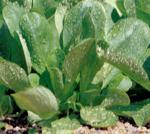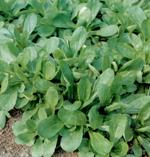| Fruits |
Vegetables
|
Corn salad, Valerianella locusta / Valerianaceae
|
Note: Composition for 100 g. of fresh product Values in ( min. - max. ) format. | |
| Energy: 13.40-13.40 kcal Fats: 0.36-0.36 g Fibres: 1.52-1.52 g Minerals Calcium: 35-35 mgZinc: 0.442-0.442 mg Chlorine: 70-70 mg Phosporus: 49-49 mg Iron: 2-2 mg Magnesium: 13-13 mg Potasium: 421-421 mg Sodium: 4-4 mg | Proteins: 1.84-1.84 kcal Carbohidrates: 0.70-0.70 g Liposoluble Vitamins A Retinol: 650-650 µgA Carotenoids: 3.90-3.90 µg E or Tocoferol: 0.6-0.6 mg Liposoluble Vitamins B1 or Thiamine: 0.065-0.065 mgB2 or Riboflavine: 0.080-0-080 mg B6 or Piridoxine: 0.25-0.25 mg B9 or Folic Acid: 35-35 mg C or Ascorbic Acid: 35-35 mg |
Corn salad is the plant with the same name given to the leaves used for human consumption. These leaves have a delicate and slightly acid taste. They are of a pale or dark green colour, intense and bright. They are usually concave and tapering towards the stem or the root, and they widen in the apex. They are grouped in rosette-like bunches. Its taste resembles that of nuts and its scent is slightly acid.
It is a wild plant of European origin. Normally, those cultivated are larger and more tender than the wild ones, but the leaves of the wild plant have a more pleasant taste.
It is a wild plant of European origin. Normally, those cultivated are larger and more tender than the wild ones, but the leaves of the wild plant have a more pleasant taste.
Nutrition and eating
The energetic value of the grass of the canons is very low, due to the few calories that it supplies. However, its consumption is highly recommended as a depurative, as well as for the vitamins and mineral salts that it supplies to the organism.
Due to its high relation potassium-sodium, it can be included in the diet of people with high blood pressure, in case cardiac failure and arteriosclerosis. It has also a great diuretic effect.
Due to its high relation potassium-sodium, it can be included in the diet of people with high blood pressure, in case cardiac failure and arteriosclerosis. It has also a great diuretic effect.
The fruit
 Salad corn is the plant with the same name given to the leaves used for human consumption. These leaves have a delicate and slightly acid taste. They are of a pale or dark green colour, intense and bright. They are usually concave and tapering towards the stem or the root, and they widen in the apex. They are grouped in rosette-like bunches. Its taste resembles that of nuts and its scent is slightly acid.
Salad corn is the plant with the same name given to the leaves used for human consumption. These leaves have a delicate and slightly acid taste. They are of a pale or dark green colour, intense and bright. They are usually concave and tapering towards the stem or the root, and they widen in the apex. They are grouped in rosette-like bunches. Its taste resembles that of nuts and its scent is slightly acid. It is a wild plant of European origin. Normally, those cultivated are larger and more tender than the wild ones, but the leaves of the wild plant have a more pleasant taste.
Like all the plants (except for the reserve organs and seeds) it is mainly composed of water and a small amount of carbohydrates, being its protein content even scarcer. Its caloric value is very low, only 13,40 kcal for each 100 g of fresh produce. For that reason it is included in slimming diets. Its nutritious value is underlined by the amount of vitamins and minerals, chiefly vitamin A, C and folic acid.
It is a highly perishable plant. It lasts 2 days in the fridge, covered with an absorbent paper or inside a perforated plastic bag.
It is usually eaten raw as part of salads. Although less frequently, it can also be cooked as a vegetable. Long ago they were highly appreciated since they enabled the supply of fresh vegetables in winter, when raw vegetables were scarce. The disadvantage of this vegetable is the great amount of soil that makes them very difficult to wash. Nowadays, they are found already washed and ready to eat (the range of pre-washed and pre-cut vegetables) thus preventing all the problems caused by the soil.
The corn salad is very similar to watercress, and its consumption is extremely limited because it is quite known in the European markets, but highly appreciated by gastronomy lovers. At present, both watercress as corn salad are part of the usual supply of the companies offering ranges of pre-washed vegetables.
The plant

The corn salad is a herbaceous plant of the family of Valerianaceae. It is a plant of annual or biennial cycle, depending on the sowing time, that produces a rosette of leaves eaten in salads. It is quite small and grows spontaneously in hidden places of the mountainous regions, wherever there is moisture. At present it is cultivated at a commercial level. This plant prefers tenuous sun and soft soil. Its harvesting takes place when the leaves are completely developed; the whole plant is cut and half centimetre of root is left to grow.
| Interempresas Media, S.L. / 2025 | [ Legal notice | Política de Protección de Datos | Política de cookies | Publicidad] |
